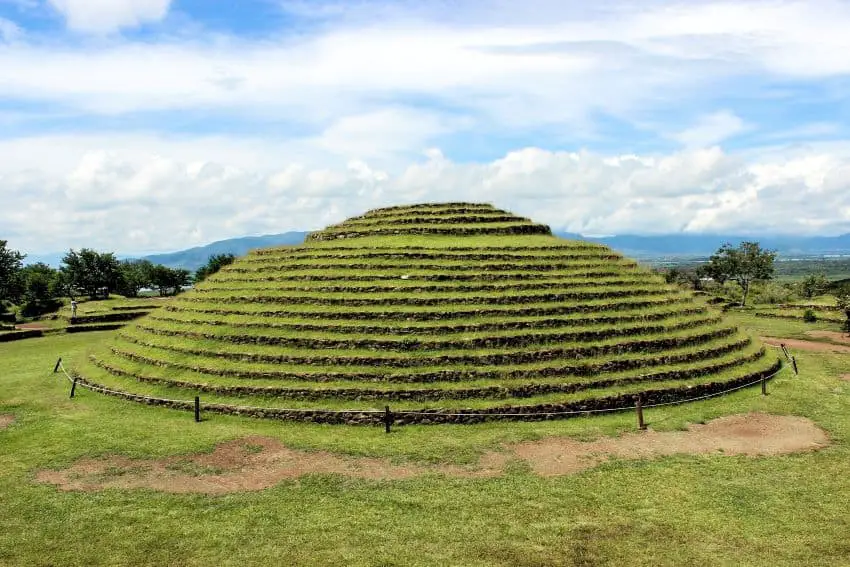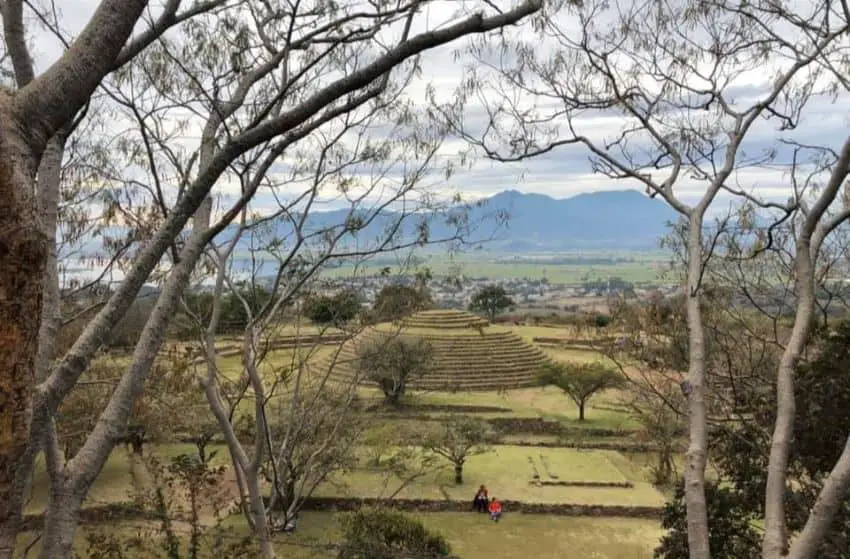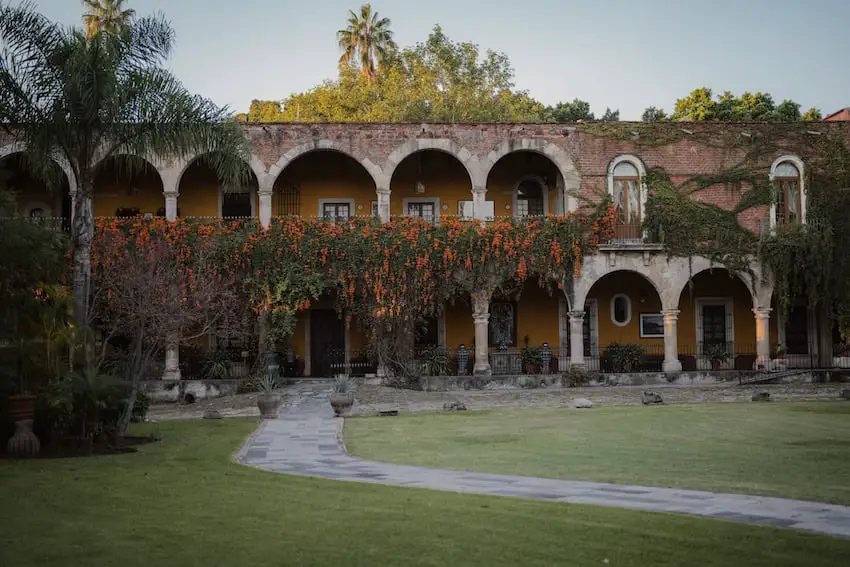Mexico’s archaeological sites are among the best in the world. Iconic ancient cities and complexes like Teotihuacan in Mexico City or Chichén Itzá in Yucatán draw thousands of visitors every year. These remnants of bygone civilizations are famed across the world and rightfully celebrated as top tourist attractions in the country. Yet, among these storied landmarks lies one of Mexico’s most mysterious and intriguing sites: The Guachimontones ruins.
Located in the state of Jalisco, near the town of Teuchitlán, Guachimontones offers a unique glimpse into a lesser-known but equally fascinating ancient culture. This pre-Hispanic site, recognized as a UNESCO World Heritage Site, is renowned for its unusual circular stepped pyramids, distinct from the more commonly seen square or rectangular structures found elsewhere in Mesoamerica.

These pyramids, ball courts, and other ceremonial spaces take visitors on a walk through history into the Teuchitlan tradition, a culture that flourished from around 300 BCE to 900 CE.
The state of Jalisco is known for different Mexican legacies: tequila, mariachi, and charrería, for example. But we can also add indigenous culture and ancient city complexes to the list of Jalisco’s heritage. A quick day trip from Guadalajara, the site of Guachimontones makes a compelling destination for travelers who want to dive deeper into the archaeology, history, and indigenous culture of this pocket of Jalisco. Read on to dive into our guide to visiting Guachimontones.
Where is Guachimontones?
Guachimontones is located in the state of Jalisco, about an hour west of Guadalajara. It’s an easy drive from the city to visit the archaeological site. Buses are also available from Guadalajara to Teuchitlan; you can take a taxi to the site from there.
History of Guachimontones
It is thought that the site of Guachimontones was inhabited from 300 BC to 350 AD and was used as a spiritual center by the Teuchitlán people. There were 10 circular complexes that surrounded the central pyramid. What remains of the structures today sit majestically perched on a grassy hill that looks down into the town of Teuchitlán.
Not a tremendous amount is known about the Teuchitlán culture but it is thought that they developed social, political, and economic systems. Their main activities revolved around agriculture, craft making, and trade.

The nearby volcano helped to create one of the largest reserves of obsidian in the world. You can find evidence of shiny black obsidian all over the complex. The original people of Teuchitlan crafted obsidian into weapons and tools and used these for trade with other Mesoamerican cultures. Their decline is also a bit of a mystery for experts, but some attribute it to environmental changes, resource depletion, or social upheaval.
The site was first excavated in the 1970s by American archaeologist Phil Weigand. Not much has changed at Guachimontones since. Walking around the circular temple complexes is like taking steps back in time. With the backdrop of the looming volcano and the undulated fields of blue-green agave plants, it’s easy to leave the 21st century behind and tap into the history of Jalisco. Guachimontones is a UNESCO World Heritage Site and a symbol of the rich culture and heritage of pre-Hispanic Jalisco.
Best Time to Visit Guachimontones
The best time to visit Guachimontones is the dry season, from November to April. The weather is warm, but not too hot. There isn’t much shade cover at the archaeological complex, so visiting before the summer heat and humidity is a plus.
If you visit just after the rainy season, the mounds will be carpeted with lush, moss colored grass, which always looks great in pictures.
Top Sites at Guachimontones

Circular Pyramids: The highlight of Guachimontones is its series of circular stepped pyramids. The largest, known as the Great Guachi, stands at around 18 meters tall.
Ball courts: Some of the largest ball courts in Mesoamerica can be found here in Guachimontones.
Interpretation Center: A recently renovated interpretation center goes deeper into the history and significance of the site through exhibits and multimedia presentations.
Hiking and nature walks: The surrounding area offers beautiful landscapes for hiking and nature walks. The Tequila Volcano is visible from the site, which adds to the drama of the backdrop.
Guided tours: Take a tour of Guachimontones with a local guide, to gain deeper insight into the history and architecture of the site.
Guachimontones is a much smaller site than Teotihuacan or Chichén Itzá. The average trip is between about one and three hours, touring the museum and the park.
Tips for Visitors to Guachimontones
Wear comfortable shoes: The site is toured on foot, which can mean quite a bit of walking. Comfortable shoes are a must.
Bring water and snacks: There are limited facilities on site, so bring water and snacks for hydration and energy.
Wear sunscreen: The site has little to no shade cover so bring a hat, sunscreen, and sunglasses.
Where to Stay near Guachimontones

Guachimontones is a quick day trip from Guadalajara, but visitors who want to experience Jalisco’s rural countryside can book a stay at a historic hacienda. Hacienda El Carmen, for example, is a 17th century retreat just 15 minutes from the archaeological site. Originally established as a sugarcane plantation, the hacienda has undergone transformations over the centuries to become the stately accommodations that it is today.
Guests are greeted to the hacienda by vine-covered yellow adobe walls, red-tiled roofs, and grand arches. The estate is set amidst lush gardens, tranquil ponds, and ancient trees. The lofty ceilinged rooms are decorated with antique furnishings and traditional Mexican decor.
While on the property, guests can indulge in spa treatments or swim in the outdoor pool. The hacienda’s on-site restaurant serves Mexican cuisine using locally sourced ingredients. If you’re only visiting Guachimontones for the day, Hacienda El Carmen is a perfect place to stop for lunch after your tour.
Meagan Drillinger is a New York native who has spent the past 15 years traveling around and writing about Mexico. While she’s on the road for assignments most of the time, Puerto Vallarta is her home base. Follow her travels on Instagram at @drillinjourneys or through her blog at drillinjourneys.com.
